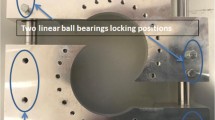Abstract
The aim of this study was to simulate the traditional investigation process of single fiber pull-out tests on quantificational basis, with an estimation of the critical length of embedded fiber and interfacial shear strength while comparing the stimulation results with empirical results. A finite element method (FEM) model of single fiber pull-out tests was established by using ANSYS parametric design language (APDL) program flow. Interfacial average shear strength was calculated and process of interfacial debonding was simulated. Single fiber pull-out tests were implemented to validate the FEM model. Results reveal that the maximum load estimated by the FEM varied as a function of both the length and critical length of the embedded fiber, and the calculated interfacial shear strength through FEM analysis is basically in agreement with the experimental results with a trivial difference of no more than 4.5%. A software was designed to simplify the simulation with respect to the analysis system of single fiber pull-out tests.
Similar content being viewed by others
References
Adusumalli R, Weber HK, Roeder T, Sixta H, Gindl W (2010) Evaluation of experimental parameters in the microbond test with regard to Lyocell fibers. J Reinf Plast Compos 29(15):2356–2367
Teuber L, Fischer H, Graupner N (2013) Single fibre pull-out test versus short beam shear test: comparing different methods to assess the interfacial shear strength. J Mater Sci 48:3248–3253
Liu L, Li L, Gao Y, Tang L, Zhang Z (2013) Single carbon fiber fracture embedded in an epoxy matrix modified by nanoparticles. Compos Sci Technol 77:101–109
Liu L, Liu Y, Han Y, Wang Q (2015) Interfacial charring method to overcome the wicking action in glass fiber-reinforced polypropylene composite. Compos Sci Technol 121:9–15
da Silva LFM, Adams RD (2016) Special issue on adhesion, surface preparation and adhesive properties. Int J Adhes Adhes 67:1–2
Müller V, Böhlke T (2016) Prediction of effective elastic properties of fiber reinforced composites using fiber orientation tensors. Compos Sci Technol 130:36–45
Bektaş NB, Akça M (2012) Stress analysis of functionally graded discs under mechanical and thermal loads: analytical and numerical solutions. Sci Eng Compos Mater 19:361–371
Gao X, Luo P, Fang G, Zhang S, Song Y (2017) Micro-XCT-based finite element method for predicting the elastic modulus of needle carbon-fiber-reinforced ceramic matrix composites. Sci Eng Compos Mater 24:1–11
He Y, Davim JP, Ma Y’e (2016) 2D macro-mechanical FE simulations for machining unidirectional FRP composite: the influence of damage models. Sci Eng Compos Mater 23:659–670
Gao C, Xiao J, Xu J, Ke Y (2016) Factor analysis of machining parameters of fiber-reinforced polymer composites based on finite element simulation with experimental investigation. Int J Adv Manuf Technol 83:1113–1125
Zhandarov S, Mäder E (2014) An alternative method of determining the local interfacial shear strength from force-displacement curves in the pull-out and microbond tests. Int J Adhes Adhes 55:37–42
Zhang Z, Liu S, Wang J, Liao H (2004) Review on synthesis and property of bisphenol type compound and epoxy resin. New Chem Mater 32:44–47 (in Chinese)
Wu J, Cheng X (2005) Effect of rare earth modifier treatment on interlaminar shear strength of aramid/epoxy composites. Raremetal Mater Eng 34:1917–1920 (in Chinese)
Webb V, Hickner M, Baird D, Lesko J, Case S (2005) Durability and performance of press molded polymer composite monopolar plates. Sci Eng Compos Mater 12:35–42
Chen S, Gao J, Han H, Wang C (2014) Mechanical and thermal properties of epoxy-POSS reinforced-(biphenyl diol formaldehyde/epoxy hybrid resin) composites. Int J Adv Manuf Technol 23:609–617
Min S, Aijuan G, Liang G, Yuan L (2011) The effect of oxygen-plasma treatment on Kevlar fibers and the properties of Kevlar fibers/bismaleimide composites. Appl Surf Sci 257:3158–3167
Garden L, Pethrick RA (2017) Critique of dielectric cure monitoring in epoxy resins—does the method work for commercial formulations? Int J Adhes Adhes 74:6–14
Miranda RA, Casebeer WD, Hein AM, Judy JW et al (2015) DARPA-funded efforts in the development of novel brain-computer interface technologies. J Neurosci Methods 244:52–67
Author information
Authors and Affiliations
Corresponding author
Rights and permissions
About this article
Cite this article
Wu, K., Xu, Y. & Cheng, X. Simulation and analysis of single fiber pull-out tests through ANSYS and VC++. Int J Adv Manuf Technol 96, 1591–1599 (2018). https://doi.org/10.1007/s00170-017-0611-8
Received:
Accepted:
Published:
Issue Date:
DOI: https://doi.org/10.1007/s00170-017-0611-8




